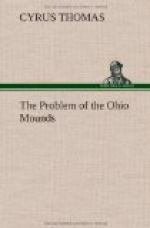These sticks being thus fastened, they make mud walls of clay, in which they put a sufficient amount of Spanish moss; these walls are not more than 4 inches thick; they leave no opening but the door, which is only 2 feet in width by 4 in height; there are some much smaller. They then cover the frame-work which I have just described with mats of reeds, putting the smoothest on the inside of the cabin, taking care to fasten them together so that they are well joined.
After this they make large bundles of grass, of the tallest that can be found in the low lands, and which is 4 or 5 feet long; this is put on in the same way as straw which is used to cover thatched houses; the grass is fastened with large canes, and splints, also of canes. When the cabin is covered with grass they cover all with a matting of canes well bound together, and at the bottom they make a ring of “bind-weeds” all around the cabin, then they trim the grass evenly, and with this defense, however strong the wind may be, it can do nothing against the cabin. These coverings last twenty years without being repaired.
Numerous other references to the same effect might be given, but these are sufficient to show that the remains found in the mounds of the South are precisely what would result from the destruction by fire of the houses in use by the Indians when first encountered by Europeans.
It is admitted now by all archaeologists that the ancient works of New York are attributable to Indians, chiefly to the Iroquois tribes. This necessarily carries with it the inference that works of the same type, for instance those of northern Ohio and eastern Michigan, are due to Indians. It is also admitted that the mounds and burial pits of Canada are due, at least in part, to the Hurons. [Footnote: David Boyle, Ann. Rept. Canadian Institute, 1886-1887, pp. 9-17; Ibid., 1888, p. 57.]
Tribal divisions.—As the proofs that the mound-builders pertained to various tribes often at war with each other are now too numerous and strong to be longer denied, we may see in them evidences of a social condition similar to that of the Indians.
Similarity in burial customs.—There are perhaps no other remains of a barbarous or unenlightened people which give us so clear a conception of their superstitions and religious beliefs as do those which relate to the disposal of their dead. By the modes adopted for such disposal, and the relics found in the receptacles of the dead, we are enabled not only to understand something of these superstitions and beliefs, but also to judge of their culture status and to gain some knowledge of their arts, customs, and modes of life.
The mortuary customs of the mound-builders, as gleaned from an examination of their burial mounds, ancient cemeteries, and other depositories of their dead, present so many striking resemblances to those of the Indians when first encountered by the whites, as to leave little room for doubt regarding their identity. [Footnote: Evidence bearing on this point will be found in the paper on The Burial Mounds of the Northern Sections, by C. Thomas, in the Fifth Annual Report of the Bureau of Ethnology.] Nor is this similarity limited to the customs in the broad and general sense, but it is carried down to the more minute and striking peculiarities.




